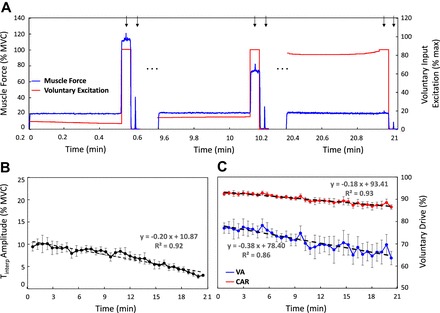Fig. 5.

Repeated submaximal voluntary contractions. A: simulated muscle force during the first, middle, and last contractions of a series of tasks sustained at 20% MVC during which peripheral fatigue developed and repeated until the endurance limit. Peripheral fatigue was modeled as a time-varying decrease in the amplitude of the force twitch of the active motor units. A 3-s maximal effort was simulated at the end of each repetition. A single maximal stimulus was simulated on the superimposed maximal effort and on the muscle at rest between contractions. Voluntary input excitation increased over time in order to compensate for the decrease in the amplitude of the motor unit force twitches (i.e., peripheral fatigue) and maintain the 20% MVC target force level (see text for details). Voluntary input excitation remained at maximal level during every maximal task to exclude the development of central fatigue. Arrows indicate the time of simulated electrical stimulation. B: amplitude of Tinterp as a function of time. C: VA and CAR as a function of time. Values are displayed as averages ± SD of the estimates from 10 repetitions of the simulated protocol.
